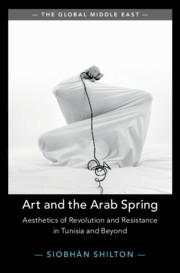Book contents
- Art and the Arab Spring
- The Global Middle East
- Art and the Arab Spring
- Copyright page
- Contents
- Figures
- Acknowledgements
- Introduction
- 1 Aesthetics of Revolution and Infra-thin Critique
- 2 Contingency and Resistance: Exceeding Icons through Matter and Motion
- 3 Contingent Encounters: Artists, Artisans and Amateurs
- 4 Corporeal Resistance and Aesthetics of the Interface
- Conclusion
- References
- Index
Introduction
Exceeding Icons of Revolution in North Africa and the Eastern Mediterranean
Published online by Cambridge University Press: 07 July 2021
- Art and the Arab Spring
- The Global Middle East
- Art and the Arab Spring
- Copyright page
- Contents
- Figures
- Acknowledgements
- Introduction
- 1 Aesthetics of Revolution and Infra-thin Critique
- 2 Contingency and Resistance: Exceeding Icons through Matter and Motion
- 3 Contingent Encounters: Artists, Artisans and Amateurs
- 4 Corporeal Resistance and Aesthetics of the Interface
- Conclusion
- References
- Index
Summary
The revolutionary wave of demonstrations and protests that began to sweep across numerous countries in North Africa and the Middle East in December 2010 shocked the world. The significance of the uneven phenomenon which has often been named the ‘Arab Spring’ is still not fully understood. What is certain is that the events triggered partly by the self-immolation of the Tunisian fruit-stall owner Mohammed Bouazizi have changed this diverse region irrevocably, leading to the explosion of enduring political frameworks or – in Syria – to civil war and mass exodus. These revolutions – like other revolutions in diverse modern historical contexts – have often tended to be articulated, internally and externally, in black-and-white terms of success or failure, liberation or constraint, for or against, friend or enemy. The complex range of perspectives in Tunisia has, for example, at times, been reduced to binary perceptions of secularism and religion or, more extremely, a ‘Western’ notion of democracy and a radical version of Islamism.
- Type
- Chapter
- Information
- Art and the Arab SpringAesthetics of Revolution and Resistance in Tunisia and Beyond, pp. 1 - 35Publisher: Cambridge University PressPrint publication year: 2021

